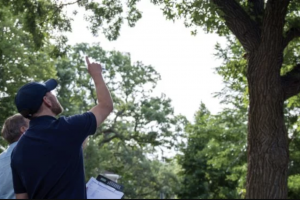Basic pruning includes removing suckers, water sprouts, dead, damaged, and crossing branches. Winter is an ideal time to prune a tree as there are fewer insects and bacteria present to attack the tree. The following tips will help maintain healthy and happy trees:
- Determine your pruning goals in advance so you will know when to prune and how much canopy you should remove.
- Work from the bottom up.
- For small material and limbs less than 1” in diameter, use hand bypass pruning pruners.
- Loppers may be used for branches from 1” to 3” in diameter.
- For larger stock greater than 3” in diameter, a pruning saw is recommended.
- Remove any sprouts (epicormic growth), dead growth, crossing branches, and branches growing either straight up or down within the canopy.
- Be safe when pruning – always wear: gloves, safety glasses, closed-toed shoes, and a hard hat.
- Never stand under the branch you are cutting.
- Keep your cutting tools clean and sharp to make clean cuts. Sharpen and oil each at the end of each season.
- Torn bark and poorly made cuts can invite pests and disease problems.
- Do not make cuts flush with the trunk, make cuts just outside the raised branch collar (branch bark ridge), inline (parallel) with the trunk, stem, branch, and twig.
- Never remove more than 25% of the living canopy at one time.
- Do not apply tar or other wound dressing to a fresh cut. These substances trap insects, bacteria, or fungi in the wound.
- Be sure to collect and dispose of all your cut branches.
- Apply antibacterial gel to cutting tools between trees to prevent spreading infection.
- Leave difficult and hard to reach work to a Licensed Certified Arborist.
Larger Limbs:
For larger limbs, removing weight helps create clean cuts. Use the following three-step method (A,B,C,) for heavy thick branches greater than 3”:
- “A” is an undercut (from the bottom) 1/3 of the way through several inches from the branch bark ridge/branch collar.
- “B” is a top cut inches further out on the limb, all the way through the branch.
- “C” is the finish cut just outside the branch bark ridge, all the way through.


Training Trees:
- Structural pruning increases the strength and longevity of trees.
- One strong central leader in a tree is the desired form. To encourage this, the smaller of the two co-dominant stems should be removed.
- Pruning replaces the natural processes that increase the strength and longevity of trees.
- Never “top” trees. This technique takes too much of the canopy, weakens the tree, and increases undesirable co-dominant stems.




